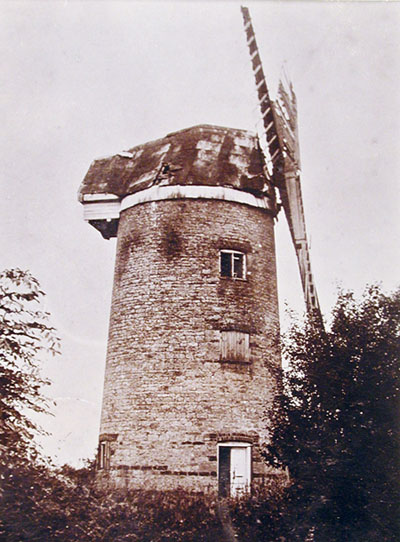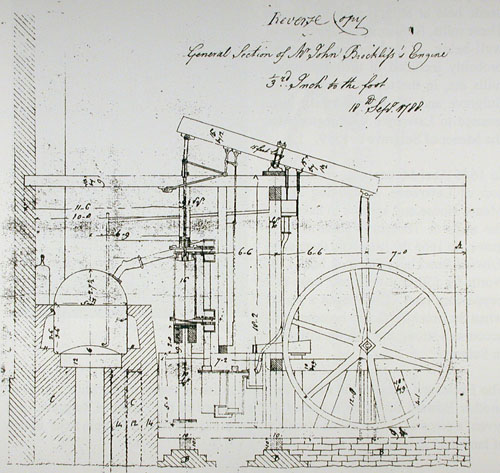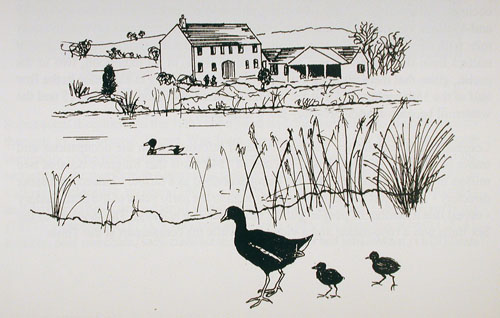
The Windmill c.1902.
SULGRAVE MILLS
(Back to Chapter 1 Index)
There used to be two mills in Sulgrave, a windmill and a watermill. The tower of the windmill, now a private house, can be seen from most parts of the village and is about halfway between Sulgrave and Culworth. The water for the watermill was provided by a large mill pond which is fed by two springs, Holy Well and Vigo which rise in the field behind Spinners Cottages. The overflow from the pool having passed through the mill forms the source of the River Tow or Tove. (Tove is derived from the old English word 'tof' meaning 'dilatory' - a reference perhaps to its winding course).
The history of the mills can be followed over a period of at least a hundred and fifty years in the collection of ancient deeds held at Sulgrave Manor House. These mills, focal points of the material well-being of the community, were probably included in the 'messuages, mills etc, in the towns or parishes of Sulgrave and Woodford' which were granted to Lawrence Washington with the Manor of Sulgrave in 1539).

The Windmill c.1902.
In 1646 Abel Makepeace, great-grandson of Lawrence, was living at the Manor House and appears to have sold the mills to Thomas Whitton of Sulgrave. In 1666 the latter sold them on to Edward Brockliss of Coaton Mill, Culworth for £50 on a 999 year lease at a peppercorn rent. Thus began a period when the Brockliss family became by all accounts a strong and wealthy influence in Sulgrave.
The Enclosure Act of 1746 names John Brockliss as owner of the mills. In 1761 another Edward Brockliss is named in the 'Award of the Parish of Sulgrave' and given 'a peice of old enclosure around the Watermill and land in Magpie field' in lieu of land held in Common Field.
The next reference to the owner of the Mills appears two years later in an acknowledgement of a debt of £7-14s-6d owing to Edward Brockliss, miller of Sulgrave, by Francis Blencowe, labourer, of Culworth.
Another document of very special interest is an agreement dated 1788, between John Brockliss of Sulgrave Mill, and Matthew Boulton and James Watt, the famous engineers of Birmingham, to erect a steam engine of eight horse power 'for the purpose of grinding wheat and other grain into meal and pressing the same into flour, and for performing such other service as it may be capable of for the use of the same mill'.
It says much for the enterprise of John Brockliss that he should set up such a deal for which he had to raise over £600 on the London Stock Exchange! The Manor holds letters giving the complete specification for the engine with drawings and corresponsence between purchaser and suppliers relative to setting-up problems and payment delays (times don't change!).

Matthew Boulton and James Watt's drawing
for John Brokliss' steam mill
Jeremiah Henn, the first historian of Sulgrave, in 1789 wrote 'The present proprietor (Mr J. Brockliss) of this spot, has a Watermill, with a neat premise, a good fish pond wheron is a boat and walk around the pond; also a steam engine for grinding corn is now erecting; indeed this sequester'd rural spot has been of late years much improved by its present owner'. Boulton and Watt in a letter of 1788 to Edward Brockliss on the subject of the proposed engine remark 'such an engine will consume about 80 pounds weight of good coals per hour when working'. Once again Henn provides the details of how this would have been brought to Sulgrave. 'Wood is very scarce; but since the canal to Banbury, about six miles distant, has been completed (1782) there is a plentiful supply of coal, at about fifteen pence to eighteen pence per hundred weight, brought here'.
However the engine obviously became too expensive to run for in about 1798 it was removed and a metal waterwheel installed. Exactly when the mills left the ownership of the Brockliss family is not known but by 1849 Whellan's Directory of Northampton names John Left as miller.
In Mercer and Crocker's Directory of 1866 Alfred Course is named as miller and farmer at Sulgrave Mill. However, in Kelly's Directory of 1885 the entry reads 'Course Alfred, miller (steam and water) baker and farmer, Sulgrave Mill'. The last mention of Sulgrave Mill is in Kelly's 1890 Directory. By 1894 Alfred Course is listed as farmer only. In the 1906 Directories, George Payne, farmer, is listed as being at Mill Farm but there is no mention of his milling activities.
The windmill ceased to function in 1915 and was shortly after destroyed by fire leaving only the shell of the tower. By 1919 the watermill had ceased operation and like the windmill is now a private house. However, the mill pond is still a delightful sight giving habitat to various waterfowl.
